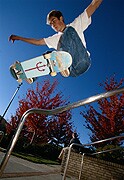- Skip Storing This Everyday Product in the Fridge Door
- Green Tea + B3 Pairing May Boost Brain Health
- Navigating Your Midlife Crisis: Embracing New Possibilities
- City Raccoons Showing Signs of Domestication
- Mapping the Exposome: Science Broadens Focus to Environmental Disease Triggers
- One Week Less on Social Media Linked to Better Mental Health
- Your Brain Changes in Stages as You Age, Study Finds
- Some Suicide Victims Show No Typical Warning Signs, Study Finds
- ByHeart Formula Faces Lawsuits After Babies Sickened With Botulism
- Switch to Vegan Diet Could Cut Your Greenhouse Gas Emissions in Half
‘Extreme Sports’ Linked to 40,000 Head and Neck Injuries Per Year


Ever since the advent of the “X Games” in the mid-1990s, Americans have embraced so-called extreme sports such as mountain biking, skateboarding and snowboarding.
But experts are warning that the fun can quickly turn to tragedy when amateurs try to mimic stunts they’ve seen on television.
A new analysis finds that extreme sports have been linked to more than 4 million injuries since 2000, and now cause more than 40,000 head and neck injuries annually.
“While we’re been inventing and coming up with all these new sports, the conversation has been all about the excitement and not about the safety,” said study co-author Dr. Vani Sabesan, an assistant professor in the department of orthopaedic surgery at Western Michigan University School of Medicine in Kalamazoo, Mich.
“We know that youth tends to push the envelope and take things to the next level,” she added. “So the tricks involved in these increasingly popular sports are becoming more and more advanced every year. And that means more and more accident risk.”
Sabesan is slated to present her findings Friday at the annual meeting of the American Academy of Orthopaedic Surgeons (AAOS) in New Orleans.
Her team reviewed information collected by the National Electronic Injury Surveillance System between 2000 and 2011.
Although the focus was on accidents involving non-professional athletes, the database also collected statistics on seven sports that currently draw in seasoned sports figures participating in either the Winter or Summer versions of the X Games. Those include surfing, mountain biking, motocross, skateboarding, snowboarding, snowmobiling and snow skiing.
According to the study, these seven sports combined were linked to more than 4 million injuries occurring over the 11-year period.
About one in every 10 of those injuries were to the head or neck. Head injuries accounted for the vast majority of that group (87 percent) when compared with neck injuries (17 percent).
About 2.5 percent of both head and neck injuries were classified as “severe,” meaning they involved a fracturing of either the skull or bones of the neck.
Overall, the sport associated with the greatest number of head and neck trauma incidents was skateboarding, which produced more than 129,000 such injuries during the study. Sabesan’s team point out that the number of Americans who skateboard has risen by nearly 50 percent, to more than 14 million, since 1999.
Snowboarding, the cold-weather cousin of skateboarding, was linked to more than 97,000 head or neck injuries. The researchers say there are now an estimated 7 million snowboarders across the United States.
Skiing ranked third on the head/neck injury list with more than 83,000 cases reported, followed by motocross with an excess of 78,000 injuries.
Overall, the annual number of head and neck injuries linked to extreme sports rose from just over 34,000 in 2000 to more than 40,000 in 2010.
Sabesan and her colleagues believe that parents — as well as those involved in organizing extreme sports teams and events — need to be aware of the risks.
“We have very young kids, and they’re getting younger all the time, going 60 miles an hour down a ski hill,” Sabesan noted. “So, the risk for life-altering accidents is real and serious.”
“Certainly, some sports have a higher risk for neck fractures, and others for concussion,” she added. “But in general we need to make sure protective equipment is available — such as helmets and wrist guards — and encouraged. And we need to make sure we provide medical care and team doctors on site, and that kids know that it’s possible to get a concussion when doing these sports and are encouraged to seek medical help when there’s any concern.”
Newly elected AAOS president Dr. Frederick Azar said the study sheds light on a relatively unexplored subject.
“The preponderance of head and neck injuries is mind-boggling, although not surprising,” said Azar, who is also chief of staff at the Campbell Clinic in Memphis, Tenn. “Because with extreme sports we’re dealing with levels of height and speed and exertion that are not always as controllable as some of the more traditional sports.”
“This work is a baseline starting point to raise awareness of the nature of the problem so we can start looking for ways to maximize safety, ” he added. “Particularly because we expect these kinds of sports to become even more popular in the coming years.”
More information
Visit the U.S. National Institutes of Health for more on head injuries.
Source: HealthDay
Copyright © 2025 HealthDay. All rights reserved.










